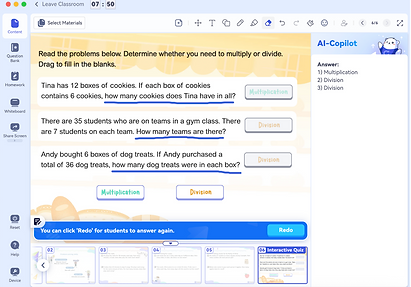Interactive Questions
Many slides are static, meaning they have text and images for you to refer to during your instruction. On these slides, you have the ability to annotate with the highlighter, pen tool, text boxes, etc. Unless you disable their ability to annotate, students have access to all of these, too.
But some questions are even more interactive for the student, meaning the student gets to click or drag to answer, and they get real-time feedback!


So how do you know if a slide is interactive? When you switch to an interactive slide, you'll see a prompt to click "start." On ELA lessons, you'll also see this icon, which indicates that a question is interactive. Once you click "start," the student should follow the instructions to answer the question. There are two types: multiple choice and drag and drop.


Some multiple-choice questions have just one correct answer, while others will ask students to select ALL the correct answers. Pay close attention to what the question is asking!

Drag and drop questions work a few different ways as well. Sometimes the answer will bounce back if it's incorrect, helping the student practice a skill, while other questions are built as more of a check for understanding, and the student won't see whether their answers were correct until after submitting.


There are visual and audio cues to indicate correct and incorrect answers. Notice the green check mark and Cosmo saying "good job" on correct answers, and the red X with Cosmo saying "almost" on incorrect answers.
As the teacher, you can, of course, add to the celebration of a correct answer! If a student answers incorrectly, you also play a valuable role in supporting and encouraging them to try again, as well as helping them understand what went wrong.
Interactive questions are meant to engage students in their learning and provide real-time feedback, never to be meant as stressful pop quizzes. You know your students best, and we trust you to make the best instructional decisions around how you use the interactive questions in your lessons.